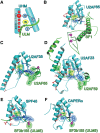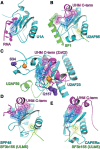Unmasking the U2AF homology motif family: a bona fide protein-protein interaction motif in disguise
- PMID: 27852923
- PMCID: PMC5113200
- DOI: 10.1261/rna.057950.116
Unmasking the U2AF homology motif family: a bona fide protein-protein interaction motif in disguise
Abstract
U2AF homology motifs (UHM) that recognize U2AF ligand motifs (ULM) are an emerging family of protein-protein interaction modules. UHM-ULM interactions recur in pre-mRNA splicing factors including U2AF1 and SF3b1, which are frequently mutated in myelodysplastic syndromes. The core topology of the UHM resembles an RNA recognition motif and is often mistakenly classified within this large family. Here, we unmask the charade and review recent discoveries of UHM-ULM modules for protein-protein interactions. Diverse polypeptide extensions and selective phosphorylation of UHM and ULM family members offer new molecular mechanisms for the assembly of specific partners in the early-stage spliceosome.
Keywords: RRM; SF3B1; U2AF1; UHM; protein–protein interaction.
© 2016 Loerch and Kielkopf; Published by Cold Spring Harbor Laboratory Press for the RNA Society.
Figures



Similar articles
-
A UHM-ULM interface with unusual structural features contributes to U2AF2 and SF3B1 association for pre-mRNA splicing.J Biol Chem. 2022 Aug;298(8):102224. doi: 10.1016/j.jbc.2022.102224. Epub 2022 Jul 1. J Biol Chem. 2022. PMID: 35780835 Free PMC article.
-
The pre-mRNA splicing and transcription factor Tat-SF1 is a functional partner of the spliceosome SF3b1 subunit via a U2AF homology motif interface.J Biol Chem. 2019 Feb 22;294(8):2892-2902. doi: 10.1074/jbc.RA118.006764. Epub 2018 Dec 19. J Biol Chem. 2019. PMID: 30567737 Free PMC article.
-
Rational Design of Cyclic Peptide Inhibitors of U2AF Homology Motif (UHM) Domains To Modulate Pre-mRNA Splicing.J Med Chem. 2016 Nov 23;59(22):10190-10197. doi: 10.1021/acs.jmedchem.6b01118. Epub 2016 Nov 4. J Med Chem. 2016. PMID: 27753493
-
U2AF homology motifs: protein recognition in the RRM world.Genes Dev. 2004 Jul 1;18(13):1513-26. doi: 10.1101/gad.1206204. Genes Dev. 2004. PMID: 15231733 Free PMC article. Review.
-
RRM-RNA recognition: NMR or crystallography…and new findings.Curr Opin Struct Biol. 2013 Feb;23(1):100-8. doi: 10.1016/j.sbi.2012.11.006. Epub 2012 Dec 14. Curr Opin Struct Biol. 2013. PMID: 23253355 Review.
Cited by
-
SPF45/RBM17-dependent, but not U2AF-dependent, splicing in a distinct subset of human short introns.Nat Commun. 2021 Aug 13;12(1):4910. doi: 10.1038/s41467-021-24879-y. Nat Commun. 2021. PMID: 34389706 Free PMC article.
-
A Comprehensive Analysis of the Alternative Splicing Co-Factor U2AF65B Gene Family Reveals Its Role in Stress Responses and Root Development.Int J Mol Sci. 2025 Apr 20;26(8):3901. doi: 10.3390/ijms26083901. Int J Mol Sci. 2025. PMID: 40332802 Free PMC article.
-
Cus2 enforces the first ATP-dependent step of splicing by binding to yeast SF3b1 through a UHM-ULM interaction.RNA. 2019 Aug;25(8):1020-1037. doi: 10.1261/rna.070649.119. Epub 2019 May 20. RNA. 2019. PMID: 31110137 Free PMC article.
-
Splicing Factor Mutations in Myelodysplasias: Insights from Spliceosome Structures.Trends Genet. 2017 May;33(5):336-348. doi: 10.1016/j.tig.2017.03.001. Epub 2017 Mar 31. Trends Genet. 2017. PMID: 28372848 Free PMC article. Review.
-
Identification of phenothiazine derivatives as UHM-binding inhibitors of early spliceosome assembly.Nat Commun. 2020 Nov 6;11(1):5621. doi: 10.1038/s41467-020-19514-1. Nat Commun. 2020. PMID: 33159082 Free PMC article.
References
-
- Avis JM, Allain FH, Howe PW, Varani G, Nagai K, Neuhaus D. 1996. Solution structure of the N-terminal RNP domain of U1A protein: the role of C-terminal residues in structure stability and RNA binding. J Mol Biol 257: 398–411. - PubMed
Publication types
MeSH terms
Substances
Grants and funding
LinkOut - more resources
Full Text Sources
Other Literature Sources
